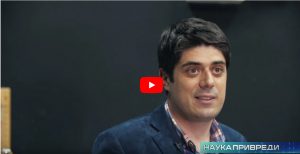PROJECT RESULTS
1. December 2021 - RAMAN SPECTROSCOPY SETUP UPGRADE
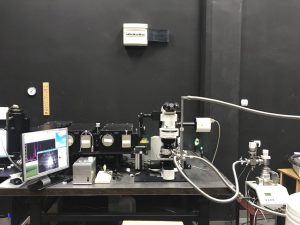 Due to the Covid-19 pandemic delays in production and delivery of the ordered equipment led to the delays in realization of the project deliverables. In order to prevent significant delays in realization of the project tasks, alternative inelastic light scattering setup was fully developed fulfilling all the requirements for conducting experiment.
Due to the Covid-19 pandemic delays in production and delivery of the ordered equipment led to the delays in realization of the project deliverables. In order to prevent significant delays in realization of the project tasks, alternative inelastic light scattering setup was fully developed fulfilling all the requirements for conducting experiment.
Moreover, the setup was designed in a way to allow easy and fast modifications depending on particular experiment requirements. Based on the acquired experience and availability of components, team members are continuing to further develop the setup.
Read more about the upgraded Raman setup in the dedicated page
1. November 2021 - PIEZO-STRAIN GAUGE SAMPLE HOLDER
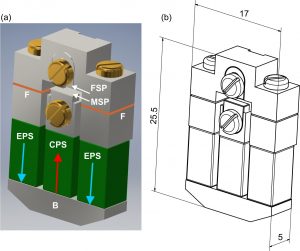
Three dimensional picture of designed sample holder is displayed in (a), geometrical drawing with indicated dimensions is depicted in (b).
In order to perform inelastic light scattering studies and scanning probe microscopy based experiments of samples under uniaxial strain, within Strained FeSC project we designed, developed and fabricated a piezoelectric-based device. For that purpose, we followed designs of similar devices for applying continuously tunable uniaxial strain that had been devised, successfully used, and publicly available [1,2].
These designs were adapted for the purposes of inelastic light scattering and scanning probe microscopy base experiments, having in mind the compatibility with the available and the cryostat that will be procured.
Read more about piezoelectric-based device here.
[1] C. W. Hicks et al. “Piezoelectric-based apparatus for strain tuning”, Rev. Sci. Instrum. 85, 065003 (2014)
[2] J. Schmidt et al. Nematicity in the superconducting mixed state of strain detwinned underdoped Ba(Fe1−xCox)2As2 , Phys. Rev. B 99, 064515 (2019)
22. June 2021 - PUBLICATION: Probing charge density wave phases and the Mott transition in 1T−TaS2 by inelastic light scattering, Phys. Rev. B 103, 24513, (2021)
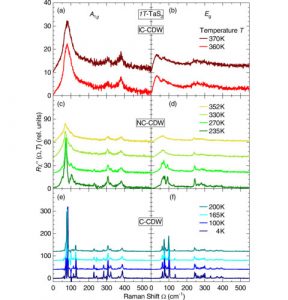
Symmetry-resolved Raman spectra of 1T−TaS2 at temperatures as indicated. Both C-CDW (blue lines) and IC-CDW (red lines) domains yield significant contributions to the Raman spectra of the NC-CDW phase (green lines).
During Q4 of the Project the research paper demonstrating the potential of using inelastic light scattering to probe the momentum dependence and energy scale of changes in the electronic structure driven by low-temperature collective quantum phenomena was published. Conclusions made during this research make important base for further understanding collective quantum phenomena and assist us in interpretation of the data obtained from Fe(Se:S) measurements.
1. June 2021 - Nauka privredi – Nenad Lazarević
1. September 2020 - INTRODUCTION
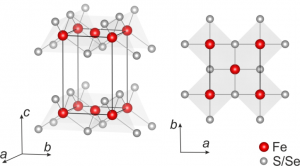
Crystal structure of FeCh (Ch = Se, S). Black line represents the crystallographic unit cell.
In recent years, piezoelectricity-based devices for applying continuously tunable uniaxial strain have been made and successfully used in combination with different experimental techniques [1-3] in a wide temperature range, including cryogenic temperatures.
By using inelastic light scattering, we will search for the spectroscopic signatures of lattice, charge and spin excitations in the full doping range of Fe(Se:S) and scrutinize their temperature and doping evolution in normal, nematic and superconducting states, thus expanding existing knowledge of the FeBSC needed for their understanding.
Temperature and polarization dependent inelastic light scattering experiments will be conducted in the full doping range of Fe(Se:S) single crystals. Particularly, our attention will be focused on the B1g symmetry spectra (B1g+A2g), since A2g symmetry channel has negligible contribution in the spectral range under consideration). Full symmetry analysis will be performed at couple of characteristic temperatures.
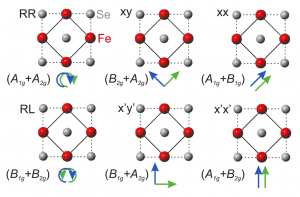
Scattering geometry of incoming (blue arrow) and scattered photons (green arrow) and projected symmetries for the ab plane of a FeBCs. Here we adopt reference system relevant for the 1 Fe unit cell. In the backscattering configuration, the arrows corresponding to R and L polarization of the scattered light should be interchanged. From [4].
Temperature, polarization and strain dependent Raman scattering study will be conducted for the samples selection based on the previous results.
Additional information about the strain influence on local electrical properties will be provided by atomic force microscopy (AFM) based electrical methods [5], Kelvin probe force microscopy (KPFM) and conductive AFM (C-AFM), and, possibly, on local magnetic properties, by a magnetic force microscopy (MFM).
Applying the tetragonal symmetry-breaking strain field, as tunable parameter, will provide additional information needed for disentangling contributions to Raman susceptibility of Fe(Se:S) coming from various degrees of freedom. Complementary information about the local electronic and, possibly, magnetic states will be obtained by SPM techniques.
DFT based methods will be used to study the structural and electronic properties and lattice dynamics of FeBCS. The vibrational properties (e.g. phonon dispersion, lattice dynamics, IR+Raman active modes and dynamical stability) will be calculated using density functional perturbation theory as implemented in the Quantum Espresso code [6].
In the iron-chalcogenide systems strong correlations i.e. Coulomb correlation effects are extremely important for the electronic bands of Fe-3d in FeBCS. This will be treated by the semi-empirical DFT+U approach, with a Hubbard +U correction [7].
[1] C. W. Hicks et al. Piezoelectric-based apparatus for strain tuning, Rev. Sci. Instrum. 85, 065003 (2014).
[2] H. Pfau et al, Detailed band structure of twinned and detwinned BaFe2As2 studied with angle-resolved photoemission spectroscopy, Phys. Rev. B 99, 035118 (2019).
[3] J. Schmidt et al. Nematicity in the superconducting mixed state of strain detwinned underdoped Ba(Fe1−xCox)2As2, Phys. Rev. B 99, 064515 (2019).
[4] N. Lazarevic and R. Hackl, Fluctuations and pairing in Fe-based superconductors: light scattering experiments,Phys.: Condens. Matter 32, 413001 (2020)
[5] S. G. Sarwat, Syed Ghazi, et al. Revealing strain-induced effects in ultrathin heterostructures at the nanoscale, Nano Lett. 18.4, 2467 (2018).
[6] S. Baroni et al., Phonons and related crystal properties from density-functional perturbation theory, Rev. Mod. Phys. 73, 515, (2001).
[7] B. Himmetoglu et al., Hubbard‐corrected DFT energy functionals: The LDA+U description of correlated systems, Int. J. of Q. Chem. 114, 1, (2014).

